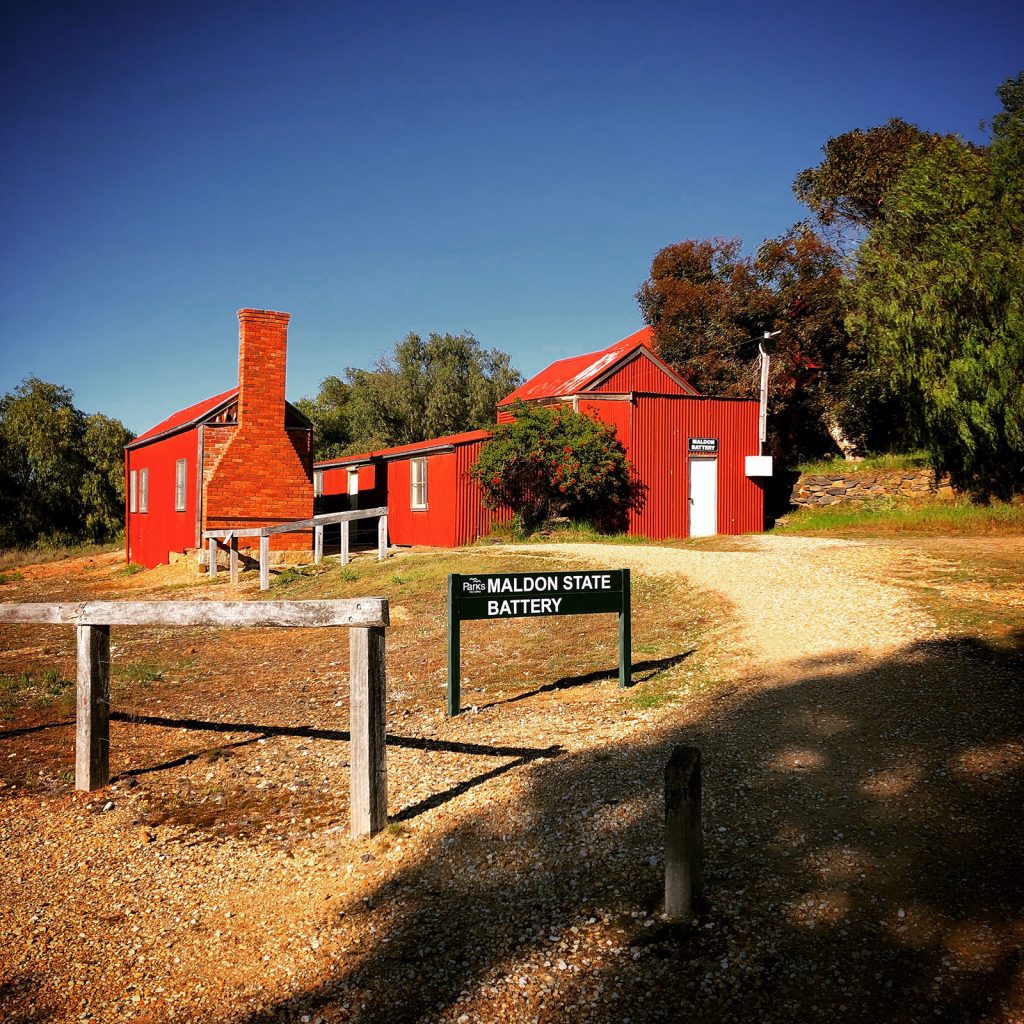
Maldon State Battery
The Maldon State Battery is a significant historical site which can be accessed via Adair Street or via walking tracks between the Union Hill Gold Mine Lookout and the Beehive Mine and Chimney Ruins.
The Battery was opened in 1915 and was last used in the 1990s. The site now consists of the former State Battery buildings and machinery, the Alliance Shaft and mining machinery foundations, sand heaps, and the site of the Welsh Swagman Joe Jenkins’ house.
The Victorian Heritage Database provides the following information regarding the Maldon State Battery:
Statement of Significance
Last updated on – July 5, 2005
The Maldon State Battery consists of the remains of the former State Battery including buildings and machinery, the Alliance shaft and associated mining machinery foundations, several large heaps of battery sand, and the site of the Joe Jenkins (the Welsh Swagman) house.
The Maldon State Battery is of historical, scientific and archaeological importance to the State of Victoria.
The Maldon State Battery is historically and scientifically important as a characteristic and well preserved example of an important form of gold mining. The Maldon State Battery is historically important as the most significant (because of its high usage) of the seven surviving State batteries.
The site is scientifically important because of the authentic quartz crushing and gold recovery technology displayed within the facility. The site’s prominence forms a significant part of the Maldon mining landscape. Gold Report generated 17/01/18 mining sites are of crucial importance for the pivotal role they have played since 1851 in the development of Victoria. As well as being a significant producer of Victoria’s nineteenth century wealth, with its intensive use of machinery, played an important role in the development of Victorian manufacturing industry.
The Maldon State Battery is archaeologically important for its potential to yield artefacts and evidence which will be able to provide significant information about the technological history of gold mining; and also to reveal new information on one of Maldon’s notable historical figures, Joe Jenkins, the Welsh Swagman.
The following text was printed in The Argus (Melbourne, VIC: 1848-1957) on Monday 20th July 1914:
STATE BATTERY FOR MALDON
MALDON, Saturday. Mr J Drysdale Brown, Minister for Mines, accompanied by Mr Merrin chief inspector of mines visited Maldon to inspect sites suitable for the erection of a Government battery. The Minister selected the spot where the Eaglehawk Consolidated battery used to stand and stated that operations would be commenced during the coming week. The despatch with which the Minister has decided to proceed with the work has given entire satisfaction as such a need has been badly felt for many years.
Source: https://trove.nla.gov.au/newspaper/article/10797362
The following text was printed in the Bendigonian (Bendigo, VIC: 1914-1918) on Tuesday 12th January 1915.
MALDON STATE BATTERY OPENED BY MINISTER.
Maldon, 5th January.Mr. J. D. Brown, M.L.C. (Minister for Mines), accompanied by Mr. I-I. S. W. Lawson (Minister for Lands) visited Maldon today for the purpose of opening the new Government battery. Owing to no official intimation having been received of the visit until this morning, the attendance at the battery was only moderate, although there must have been 100 prospectors and business people present when the ceremony was performed. The battery consists of five heads and a complete cyanide plant, and is the most up-to-date of its kind in the State. As soon :as the battery was started, the shire president (Cr. Hutton) broke a bottle of champagne over the flywheel amid cheers.
Mr. Brown said, owing to representations by Mr. Lawson and residents of Maldon, he had agreed to have the battery erected, and he would be delighted it it could be kept going. It should have been erected three months ago. It was the 28th battery of its kind, and although there was talk of difficulties in the treatment of sand, he thought that would be overcome by the appointment of a local trust to manage the whole affair. The object of the battery was to assist the prospector and working miner to find payable stone and to treat the stone, at a cheap rate. The department was not going to enter into the business of dealing with the sand. If the battery was supported, the department would erect another five heads of stampers, but if it was found at the end of six months that it was not being used, it would be shipped. elsewhere, where it would be appreciated. The battery cost £2000, and he hoped it would be a sample of its kind for the rest of Victoria. He trusted it would be kept going, as the charge for crushing would be 5/ a ton. He wished the venture every success (Applause.)
Mr. Lawson said that such a battery was a necessity, and he hoped its erection would lead prospectors to locate something permanent for the benefit of the district. They were sincerely anxious to help the working miner, and any practical suggestion would be sympathetically considered by the Minister for Mines, who would endeavor to carry them out. Personally, he was pushing on the new water scheme with all possible speed, and he hoped that when completed, it would prove satisfactory, and put an end to the threatened water famines which had troubled them for so many years. He wished the new venture every success, and congratulated the people of Maldon on possessing a State Battery. (Applause.)
Cr. Bowen moved a vote of thanks to the Ministers for their attendance, and for their efforts in securing the battery. The motion was carried by acclamation. Subsequently Cr. Hutton invited the company to partake of a glass of wine at the Eaglehawk Hotel, and subsequently he entertained the visitors at luncheon at the Royal Hotel, The visitors left in the afternoon for the metropolis.

